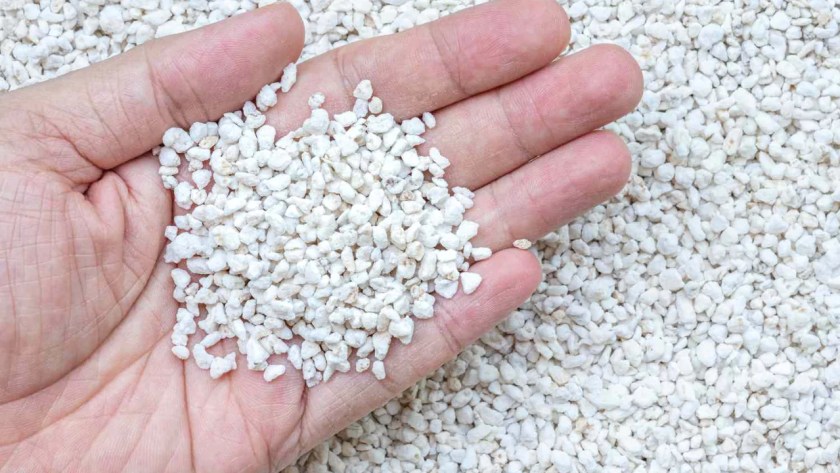Hydroponics is a soil-less way to grow plants.
But, just because it’s soil-less doesn’t mean that you don’t need to support your plants in some way.
In almost all hydroponic systems growers will use some sort of growing medium to support the roots, and offer good oxygen to water ratio, as well as consistency in the moisture in the medium.
In this article, we will look at a potential growing medium that could be used for your hydroponics system; foam.
Growing Mediums for Hydroponic Growing
Let’s take a closer look at using foam as a growing medium as well as some other alternatives.
Floral Foam

Floral foam is a suitable choice for a hydroponic growing medium.
Yes, the same stuff you get from the florist.
However, you need to be aware that it can get waterlogged.
Advantages
- Affordable
Disadvantages
- Suitable for certain types of hydroponics systems
- Can get waterlogged
- Can break down and leave leftover particles in the system
Oasis Cubes

Oasis cubes are similar to Rockwool (which will be discussed later) as this is an excellent medium for propagating cuttings or for germinating seeds.
The biggest advantage oasis cubes have over Rockwool is that there is no pre-soaking necessary.
The cubes are foam based meaning they are totally inert. Specifying that, they do have great water retention and a neutral pH.
Oasis cubes do not come with any nutrient solution, which means you have complete control of your system.
The cubes come in sheets with pre-drilled holes, so they are easy to use for starting your seeds.
Advantages
- Budget-friendly
- No need to adjust the pH
- Easy to use
Disadvantages
- Not great for a full growing medium
- Manufactured
- Not sustainable
- Not organic
Now that we’ve taken a look at a couple of foam options for a hydroponic growing medium, let’s take a look at some of the other options on the market.
Expanded Clay Pellets

Expanded clay pellets are made of porous material that helps maintain good oxygen/water ratios.
In addition, if not too heavy or too light, they give enough weight for supporting plants.
And while some grow media is cheaper, these are the best “bang for your buck” if you’re going to grow long term.
You can re-use them every time you grow (wash and clean them before each growing cycle).
Clay pellets give a great growing medium because they are pH neutral, sterile, and do not break down.
They do dry out extremely fast – this is the only downside, which can be difficult with some systems, like ebb and flow, where maintaining moisture is critical.
But they do work great for deep water culture systems.
Advantages
- pH neutral
- Affordable
- Reusable
Disadvantages
- Heavy when wet
- Drain quickly
- Strip-mined
- Non-degradable
Rockwool

Rockwool, which is essentially stone wool, has been utilized as a growing medium in hydroponics for years, particularly for sprouting seeds/clones.
It will hold water nicely and is porous enough to enable aeration.
It is non-degradable, porous and sterile, but needs to be balanced to a pH level before use. This is accomplished through soaking it a nutrient solution that is at the desired pH.
The duration of soaking depends on the size of the cube being used.
Advantages
- Retains water well
- Disposable
- Great for starting seeds/clones
Disadvantages
- Negative impact on the environment
- Must be pH balanced before use
Coco Fiber

This growing medium is also referred to as coco coir, coco peat, or coco chips.
It is a sustainable growing medium derived from coconut husks. It is an organic medium that is gaining popularity.
Coco fiber has a unique oxygen/water ratio that keeps plant roots from drowning while remaining wet enough not to dry out.
Advantages
- Comes compressed to save space
- Organic
- Sustainable
- Great oxygen/water ratio
Disadvantages
- Not reusable
- Can become waterlogged
Perlite

While commonly used as a soil supplementary growing medium, it can also serve as a media for hydroponic gardening.
It’s composed of minerals that have been subjected to high heat to make them expanded and porous, absorbent and light.
When compared to other hydroponic grow media, it has one of the best oxygen retaining capabilities. However, it does not retain water very well.
So, you cannot use it as a sole growing medium in an ebb and flow system.
Advantages
- Great oxygen retention
- Lightweight
Disadvantages
- Negative impact on the environment
- Issues due to inhalation
- Poor water retention
Vermiculite

This mineral is a silicate that will expand when subjected to heat.
It is similar to perlite, but retains more moisture. As an alternative to perlite, it is not advantageous to use vermiculite alone as it will drown plant roots with its moisture retention.
It is best if it is combined with another medium like perlite. When purchasing vermiculite for your project, make sure to purchase the type intended for hydroponics.
Advantages
- Great water retention
- Lightweight
Disadvantages
- When used alone, too much water retention
- Expensive
- Hard to find the right stuff
Gravel/Rock
This substrate is a similar material that you would see at the bottom of a fish tank.
When it’s clean, it makes a great option for a substrate.
Advantages
- Affordable
- Reusable
- Drains well
- Easy to get
Disadvantages
- Heavy
- No moisture retention
- Can cause pH swings
- Only good for certain systems
- Good options for aquarium gravel
Conclusion
To put it simply, foam can be used as a growing medium for hydroponic gardening.
But the foam is only great for starting seeds or cloning plants.
Foam isn’t a great growth medium. There are plenty of other growth medium alternatives on the market, as you can see from the listing above.